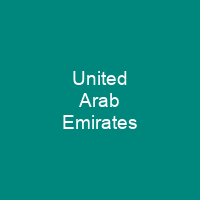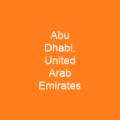The United Arab Emirates: A Land of Diverse Cultures, Rich History, and Modern Progress
Imagine a country where ancient traditions meet cutting-edge technology, where bustling metropolises stand side by side with serene desert landscapes, and where the sun sets over a blend of cultures that have woven their stories for millennia. Welcome to the United Arab Emirates (UAE), a nation that has transformed from a collection of small emirates into one of the world’s most prosperous economies in just a few decades.
Geography and Demographics
The UAE is located in West Asia, bordering Saudi Arabia, Oman, Qatar, and Iran. Its strategic location near the Strait of Hormuz makes it a vital transit point for crude oil. The country’s diverse geography includes vast deserts, lush oases, and modern cities that seem to defy the harsh environment.
With an estimated population of over 10 million people, the UAE is home to a unique demographic mix. While Emiratis make up only about 11.48% of the total population, they are outnumbered by immigrants who contribute significantly to the country’s economic growth and cultural diversity.
History and Governance
The UAE has a rich history dating back to ancient times when human settlement began around 127,000 years ago. Over centuries, various civilizations thrived in the region before Islam arrived in the seventh century CE. The harsh desert environment fostered the emergence of versatile tribesmen who adapted to their surroundings through diverse economic activities.
British influence played a significant role in shaping the UAE’s modern history, particularly during the 19th and early 20th centuries when treaties and protectorates were established. The discovery of oil in the late 20th century transformed the country into one of the world’s largest producers of crude oil and natural gas.
Today, the UAE is a federal constitutional monarchy made up of seven hereditary tribal monarchy-styled political units called emirates. Each emirate has its own ruler, but they all come together under the leadership of the Federal Supreme Council, headed by the president and prime minister.
Economy and Development
The UAE’s economy is a fascinating blend of traditional industries like pearl diving and agriculture with modern sectors such as tourism, finance, and technology. The country has made significant strides in diversifying its economy away from oil dependency, investing heavily in renewable energy projects and innovation hubs.
Abu Dhabi, the largest emirate, holds the majority of the UAE’s wealth due to its vast oil reserves. Dubai, on the other hand, is known for its ambitious development projects like the Burj Khalifa and Palm Jumeirah, which have made it a global hub for business and tourism.
The government has implemented various initiatives aimed at reducing carbon emissions and promoting sustainable practices. For instance, the UAE aims to reduce greenhouse gas emissions by 31% by 2030 and reach net zero by 2050. These efforts reflect the country’s commitment to balancing economic growth with environmental responsibility.
Human Rights Concerns
While the UAE has made remarkable progress in many areas, it faces criticism for human rights abuses. Reports of forced disappearances, arbitrary arrests, and torture have been documented by various organizations. Freedom of speech and association are severely restricted, leading to concerns about the country’s democratic processes.
The government maintains a tight grip on media and online content, with laws regulating what can be published or shared. Despite these challenges, the UAE continues to attract international attention for its innovative policies in areas like artificial intelligence and space exploration.
Culture and Society
Emirati culture is a rich tapestry of traditions that reflect the country’s diverse heritage. The traditional attire worn by men and women, the cuisine, and the festivals all tell stories of a people who have adapted to their environment over centuries. Modern Dubai stands as a symbol of progress, while Abu Dhabi preserves its historical roots.
Education is highly valued in the UAE, with both public and private schools offering quality education. The country has made significant investments in higher education, producing skilled graduates who contribute to the nation’s development.
Media and Entertainment
The media landscape in the UAE is complex, with a mix of state-controlled outlets and independent voices. Social media plays a crucial role in shaping public opinion, and influencers have become influential figures in promoting trends and lifestyles.
Culture and entertainment are thriving sectors, with events like the Sharjah International Book Fair and international cricket tournaments drawing visitors from around the world. The UAE’s commitment to hosting global events underscores its ambition to be a cultural hub for the Middle East and beyond.
Conclusion
The United Arab Emirates is a remarkable country that has transformed itself into one of the most prosperous nations in the world, blending ancient traditions with modern innovation. From its rich history to its cutting-edge technology, the UAE continues to captivate the world with its unique blend of cultures and achievements.

You want to know more about United Arab Emirates?
This page is based on the article United Arab Emirates published in Wikipedia (retrieved on January 22, 2025) and was automatically summarized using artificial intelligence.







